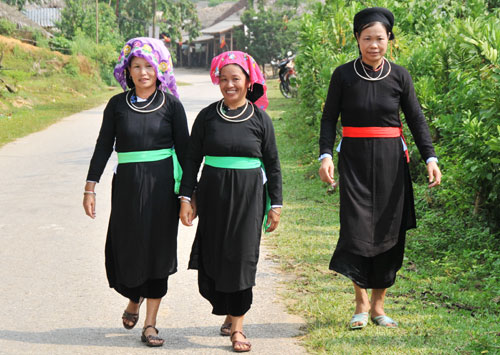

Biking Tour - 2 days to TamDuong
Biking Tour - 2 days to ThanhPhu-Sinchai-BanHo
SAPA PEOPLES

The population of the Lào Cai province is a mosaic of ethnic groups. An incredible variety of peoples, some of them unique to Vietnam, are found on a relatively small area.
In fact, visitors can meet 24 ethnic groups, each with its own language, culture and traditions. This cultural wealth is explained by the diversity of landscapes and of land available for farming. History also offers clues as to why the highlands in the Lào Cai province served as a refuge for certain ethnic groups during political unrest like the Taiping rebellion in 19th-century China.
The seven most numerous ethnic groups in the Lào Cai province account for over 90% of the whole population. The following groups are found: the Kinh (the true Vietnamese) 35%, the Hmong 22%, the Tay 14%, the Dao (Mien) 13%, the Thai 9%, the Nung 4.5% and the Giay 4.3%. The other ethnic groups: the Phula, Hani, Latis, Tu Di, Pin Tao, Tu Lao, Pa Di, Sapho, Lolo and the Xa Mang are sometimes represented only by a few villages and a few hundred individuals.
The Hmong people

The main subgroups present in Vietnam are the White Hmong, the Hmong Leng, Hmong Pua, Hmong Shi or Sheu and the black Hmong. In Sa Pa, the Hmong Leng are the most numerous, some Hmong Sheu and Hmong Pe women – with their colorful skirts and double-breasted tops – come from the Muong Khuong district.
Today, the traditional agrarian economy is still based on family farms raising pigs, chickens, buffaloes and horses, on food crops (rice, corn, manioc) and cash crops (cardamom and vegetables).
The traditional social organization of the Hmong is based on the clan. Each clan is made of lineages, all the members of which acknowledge a common founding male ancestor. In the Hmong household, up to four different generations may be gathered under the same roof. The household is the most important economic, political and ritual unit. The villages perched on the mountain slopes house several clans.
Easily recognizable by their costume, the Sa Pa Hmong Leng – who do not call themselves Black Hmongs – still wear hemp clothes dyed with natural (black-blue) indigo. The women wear stiff indigo-blue turbans over their hair gathered into a bun. Nowadays, they hardly ever wear their batik or embroidered pleated skirts, replaced with short indigo pants. Only the collar, sleeves and belt are embroidered with geometric patterns in silk.
The White Hmong women from the Bat Xat district wear long black pants, fairly short-waisted double-breasted jackets, and cover their hair with colourful head scarves.
The Hmong Pua, Hmong Pe and Hmong Sheu women from the Bac Ha district wear similar batik skirts with an embroidered band. They are distinguished by the decorative patterns and shape of their aprons.
The Dao people
The Dao, known as the Man or Yao in south-west China for centuries, also number a few tens of thousands in Laos, Thailand and Myanmar (formerly Burma).
Like the Hmong, the Dao build terraced paddy-fields irrigated by a sophisticated system of canals around Sa Pa. They also have a reputation for pig and horse breeding.
The different Dao groups from the Lao Cai province usually wear red headdresses or red pieces of clothing. The Dao (Ké Mien) from the Taphin and Tavan villages (Sa Pa district) wear flat headdresses, totally red, hung with silver coins. The headdresses of the Dao (Ké Mien) from Muong Hum district (north of Sa Pa) are cone-shaped and made of red flowery material. The Bac Ha (Ké Moun) Dao enhance their turbans with red and pink wool or silk threads. The headdresses of the Dao (Iu Mien) from Van Ban district – south of Sa Pa – are decorated with red and yellow pompoms, and hang low down their backs.
The Tay people

The Tày grow rice in paddy fields, preferably in the plains and in the valleys. The villages consist of wooden or bamboo stilt houses and are often built in the immediate vicinity of a stream or a river. The household is the basic economic unit and tends to be a nuclear family limited to close relatives.
The Tày, Giay, Numg and Thai women wear brightly-colored jackets, – pink, green, or blue – double-breasted, often with contrasting braid at the collar. The tartan headscarf covers their hair gathered into a bun. Traditionally, each group used to have their own style of bun, held up with long silver needles, but the custom is vanishing.
The Giay peopele
The Giay (pronounced”Zay”) are a relatively small minority group, with a population of around 40,000, living at high altitudes in Lao Cai, Lai Chau and Ha Giang provinces. Traditional Giay society is feudal, with a strict demarcation between the local aristocracy and the peasant classes. All villagers work the communal lands, living in closely knit villages of stilt houses. A few Giay women still wear the traditional style of dress, distinguished by the highly colored, circular panel sewn around the collar and a shirt-fastening on the right shoulder: the shirt itself is often of bright green, pink or blue. On formal occasions, women may also wear a chequered turban.










